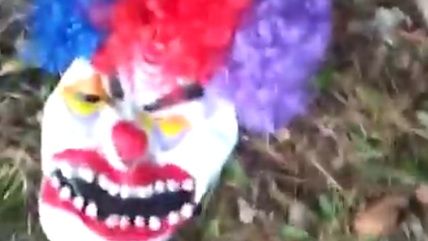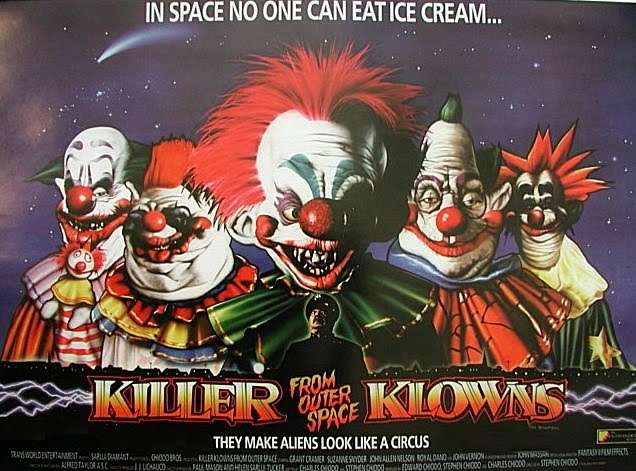Friday A/V Club: A Short History of Phantom Clowns
This isn't our first freakout about imaginary Bozos.


The Great Clown Scare of 2016 began last month, and a larger set of creepy-clown sightings have been flaring up in different spots around the globe for a few years now. But rumors of malevolent jesters have circulated much longer than that. The size and intensity of the current clown panic may be unprecedented, but the phenomenon itself is not.
In the spring of 1981, according to Benjamin Radford's recent book Bad Clowns, "police in Brookline, Massachusetts, issued an all-points bulletin asking officers to watch for a vehicle containing potential child abductors. The vehicle was distinctive: an older-model van with a broken headlight, no hubcaps, and ladders on the side. It was also full of clowns. Several children reported that clowns had tried to lure them into the dark van with promises of candy, and the sinister white-faced vagabonds were later reported lurking near Brookline's Lawrence Elementary School."
Similar reports soon popped up in other parts of the country—Omaha, Kansas City, Pittsburgh. A story in the Pittsburgh Press noted that in some of these cities, the rumors were coming from predominantly black parts of town, and the paper cited some speculation that they were a local reaction to the series of killings in Atlanta that seemed to be targeting African-American children. The Fortean writer Loren Coleman dubbed the mystery harlequinns "phantom clowns," and the name stuck.
It probably wasn't the first clown panic, and it certainly wasn't the last. In 1982, a newspaper columnist in the Pittsburgh area was relaying "unfounded rumors of clown sightings in the vicinity of North Franklin Elementary School." That might have just been an echo of the stories that had hit the same city a year earlier, but before long the rumors were appearing in other parts of America. In 1985, for instance, clown gangs were said to be stalking Phoenix. In 1991, kids in New Jersey started claiming that a man called Homey the Clown—yes, like the In Living Color character—was lurking through the streets, searching for kids to snatch. The Homey rumors prompted Jan Harold Brunvand, author of several books on urban legends, to ask, "How long before the phantom clowns of New Jersey start to show up in other communities?" Not long at all: Homey was soon terrorizing the kids of Chicago too. (When another wave of scary-clown sightings hit the Windy City in 2008, Chicagoans with long memories started reminiscing about Homey.)
Just as the tales of '81 may have been linked to the Atlanta murders, the later legends often went hand-in-hand with larger panics. The '80s were a time of heightened anxieties about missing children, and the kidnapper-clowns fit in easily with the Satanic cults and other malign forces allegedly chasing the country's kids. In the '90s, rumors in Central America combined the urban legend of the clowns with the urban legend that a conspiracy was seizing children to steal their organs. And of course some of these rumors were basically age-old folktales with clowns inserted into the villain role. If you've heard any of those myths about gypsies grabbing white children, then a lot of the clown lore will sound familiar.
None of these reports, in any of these cities, were ever substantiated. Always a Boogieman, never a John Wayne Gacy.
Is there anything different about the current scare? Well, there's the sheer size of it. There's the role the Internet has played in quickening and intensifying it. And there may be something else. Radford points out that in the early cases, "only young children reported seeing [the phantom clowns]; adults almost never encountered them." But this time around, some twentysomething pranksters have been arrested for making false reports, and in one case for posing as one of the clowns. I can't say for sure, but it's possible that the kids are carrying less of the load this time.
Still, children have been doing the bulk of the storytelling. And that takes us to the A/V part of this post. You see, in addition to all those playground and Facebook rumors, there is a whole YouTube mini-genre of hoax creepy-clown videos made by kids.
Here's one that predates the present panic. (It's from 2010.) A couple of kids are chatting away near an overpass. One puts down his camera to answer the phone. The camera keeps running while he talks, and that just happens to be the moment a mysterious clown emerges from the tunnel below the bridge, then silently retreats:
As you'd expect, the genre has really taken off since the current clown scare began. From last week, for example, here is a boy "finding" a clown mask in the woods and pretending to freak out about it:
This next vid is unusual in that a parent participates in it. It's part of a whole series of clips in which the family looks for clowns in the woods; I haven't watched the entire sequence, but in what I've seen so far they haven't discovered anything spookier than a footprint. There is a chance that the people producing it are sincere. There is also a chance that they're building toward a final installment that'll end with a neighbor jumping out in a clown suit:
Our final selection purports to show an actual clown attack. The young auteurs who made it have got that Blair Witch shaky-cam aesthetic down pat, but they haven't embraced the Blair Witch idea of letting the monster lurk unseen. They also ignore another Hollywood notion—that if one of your pals is standing around looking bored, you should try to keep him out of your shot. That just makes it more great, of course. This one is definitely my favorite:
That last effort reminds me of an incident in Brunvand's article: "One child, who later retracted his story, told police that a clown holding a machete in one hand and an Uzi machine gun in the other fired five shots at him before he drove him off with his bookbag." (That must've been one hell of a bookbag.)
What do these videos show us? For one thing, pretty much everyone involved is clearly having fun. It's easy to focus on the fear-filled side of a scare—that's why we call 'em scares!—but surely one thing driving these little rumor-manias is the sheer pleasure of spreading a spooky story. The New Jersey kid who made up that Uzi yarn 25 years ago was probably having a blast too, at least up until the point where he was talking to skeptical cops instead of, say, some younger kids on the playground.
The videos also drive home how much of this comes down to children being children. Kids like to play pranks. Kids like to tell stories. Kids like to hear stories. Kids scare easily. Kids don't always have well-honed bullshit filters. Kids eventually turn into grown-ups, and you know what? We don't necessarily change that much in the process.
(For past editions of the Friday A/V Club, go here.)


Show Comments (33)